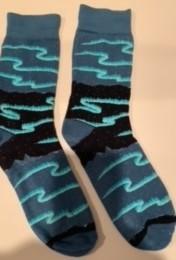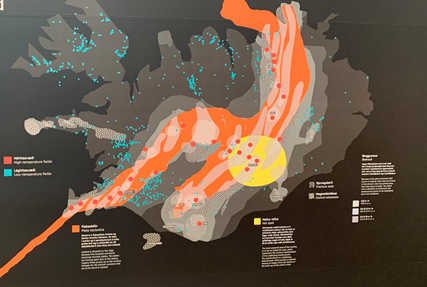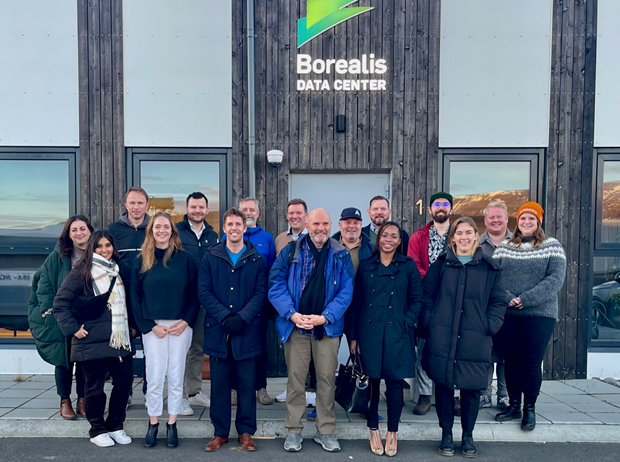Visiting Iceland with a group of tech and business journalists for five days in late October reminded me of reading The Innocents Abroad by Mark Twain because I was unfamiliar with the island and worried I would come off as an absolutely naive American rube.

Luckily, there were some Brits and an Irish Times writer in the group who knew a thing or two more about data center sustainability than I. Our friendly hosts also answered all our questions. I flew into the capital of Reykjavic recalling Iceland was geologically active and found out there are plenty of volcanos, several active ones, and hundreds of daily minor earthquakes. We even hoped to see the northern lights, but, alas, did not. (I bought fashion socks with a northern lights design instead.)
Our invite came from Data Centers by Iceland, which sponsored the trip. The public-private entity focuses on attracting growing data centers from the around the globe to the North Atlantic island. They and providers atNorth and Borealis Data Center are pitching low energy costs and the chance to engage in environmental sustainability, mainly by cooling data centers with chilly artic waters and low temperature ambient air or benefiting from electricity derived from using hot geothermal water and steam, which drives turbines and generators. And, yes, the country also offers old-fashioned hydraulic power from its many rivers and waterfalls.
However, the biggest sustainability message came in the form of work by an ON Power subsidiary, Carbfix, to take CO2 from the geothermal water used in the production of electricity and then to inject it back into the earth. This is really happening, which just blew my mind. I wrote more about it here, although Carbfix does a nice job explaining it all on its website where it says it has injected more than 97,000 metric tons of CO2 since 2014.
RELATED: Iceland’s bid to bury CO2, amid volcanos, earthquakes
Here are a few things I learned in Iceland:
1. There is a geologic fault line down the middle of the island, running northeast to southwest, separating the vast North American and European tectonic plates. The plates are moving apart slightly all the time (less than 1 centimeter a year), causing the geologic activity, including widespread reactions between minerals and water inside fissures deep in the earth that lead to volcanos, earthquakes, geysers and more. Several natives of this country of 400,000 said they saw a volcano smoking west of Reykjavik in 2022 for a few weeks as it erupted under a glacier and boiled the ice into steam. One report indicated 300 minor earthquakes on the morning after we departed by our small bus from Reykjavik, but nobody really seemed to care that much. Tourists and some residents are more concerned that their hot water from the earth carries a rotten egg smell from its sulfur content. I wrote earlier about some of this:
RELATED: Iceland uses geothermal energy for heat, electricity, cucumbers
Yes, cucumbers! Geologic activity and geothermal power help keep the lights on in greenhouses at farms to raise vegetables and fruits, which are in almost impossible to grow natively because of the cold conditions and shortage of daylight hours much of the year. The island grows enough cucumbers that it can even export them to Nordic neighbors. Cucumbers and tomatoes appeared alongside nearly every dish we ate through our weeklong visit.
2. Iceland officials, including President Guoni Johannesson on down the line, are keen on promoting Iceland as the sustainable country, and a prime place for setting up a data center through co-location or leasing of bare iron. “Sustainable and green energy—that’s us,” he declared at a DataCenter Forum event at the Groska tech part in the capital city. Our intrepid group of journalists attended the event along with some companies clearly assessing Iceland as a data center site.
RELATED: Iceland president touts nation’s role as green data center spot
Einar Tomasson, the nation’s film commissioner and head of energy and green solutions, said companies do worry about co-locating in Iceland because of the threat of volcanoes and earthquakes, not to be mention blizzards and the potential for power outages. But data centers build in redundancies for such concerns and Iceland even has a fiber ring topology for backups as well as a recent IRIS submarine fiber link to Ireland, atop two earlier submarine fiber links to other countries. As for the earthquakes, he told me, there are companies still building data centers in California near an earthquake fault line there, but in that case the tectonic plates are colliding, not moving apart as in Iceland. (I’m glad I don’t personally have to decide where to build a data center to be honest.)

3. There really are companies moving data centers to Iceland. While it is hard to get a handle on how many have answered Iceland’s call, Shearwater GeoServices described in a slide presentation its move to an atNorth data center in Iceland from the UK where it was experiencing rolling blackouts. The company projects an 85% reduction in power costs in Iceland, while gaining a 90% carbon reduction.
RELATED: Shearwater’s data center move to Iceland lowers energy costs, ups sustainability
4. One of the biggest things I learned is how much of Iceland depends on tourism, like many small countries in other parts of the world. Our group, as much tourists as hard-nosed professionals, ate grilled lamb and salmon at fantastic restaurants and had a hearty daily breakfast that always included plenty of Skyr, a strained yogurt with a mild flavor. The biggest tourist feature for Iceland, undoubtedly, is soaking in geothermic water in lagoons or captured in luxurious pools. Our tour sponsors said natives will spend every evening in such pools, which become like the corner pub for families and friends, but done while soaking under the stars with the water at 103 degrees F. and air temperature at 30 degrees F--or much colder. It is eerie and calming to sit in a soaking pool watching steam rise into the dark night. These same hot waters are supplied to homes and businesses throughout Iceland.
Tidbits I learned: Iceland is a Nordic country, but not Scandinavian, and is a member of NATO but not the European Union. As such, it relies on the Icelandic Krona currency, so that one US dollar equals nearly 140 Krona. Just about everything on our trip seemed expensive. I’m not sure if prices were out of line with other Nordic countries, however.
5. I realize now how Iceland is very willing to explain its lifestyle and commitment to green and sustainability. It doesn’t seem to me that the US or its big states or cities (and big companies) are doing anything similar or at least with such zeal, maybe because politically it is not easy to say your company is green without also appearing liberal or woke, which is a supercharged term these days and has variable meanings. Iceland has three big aluminum smelting operations and knows how important it is for businesses to prepare for a continuing explosion of AI and computing power, which is energy intensive, as many bitcoin data mining facilities have shown in cities around the globe.
The big message of this trip: AI and high performance computing promise tremendous benefits, but at what environmental cost? And are we all doing enough about reducing those impacts or prepping the energy alternatives to provide the needed power? Amsterdam has restricted more data centers for these reasons and Dublin has not recently been able to approve and provide the power needed for more data centers.
Meanwhile, some huge data centers are being built in the US, especially in Virginia outside of Washington, DC. Northern Virginia alone has 275 data centers with 2,600 megawatts of commissioned power, four times as much power as the next largest data center location in Dallas, Texas, according to Dgtl Infra. Clearly, there’s not likely to be the same reliance on geothermal power in the US as Iceland, but solar, wind and other sources are coming into vogue.
In sum, I'd say there is much to learn from Iceland, even though it is relatively small compared to other countries in population and data centers. Clearly, I’ve only scratched the surface…of this ice.
